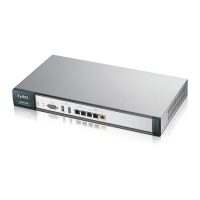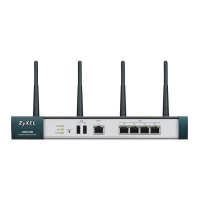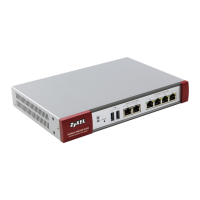Chapter 31 Bandwidth Management
UAG Series User’s Guide
371
Figure 255 Configuration > BWM
The following table describes the labels in this screen. See Section 31.2.1 on page 372 for more
information as well.
Table 165 Configuration > BWM
LABEL DESCRIPTION
Enable BWM Select this check box to activate management bandwidth.
Enable Highest
Bandwidth
Priority for SIP
Traffic
Select this to maximize the throughput of SIP traffic to improve SIP-based VoIP call sound
quality. This has the UAG immediately send SIP traffic upon identifying it. When this option
is enabled the UAG ignores any other application patrol rules for SIP traffic (so there is no
bandwidth control for SIP traffic) and does not record SIP traffic bandwidth usage
statistics.
Add Click this to create a new entry. Select an entry and click Add to create a new entry after
the selected entry.
Edit Select an entry and click this to be able to modify it.
Remove Select an entry and click this to delete it.
Activate To turn on an entry, select it and click Activate.
Inactivate To turn off an entry, select it and click Inactivate.
Move To change an entry’s position in the numbered list, select it and click Move to display a
field to type a number for where you want to put that entry and press [ENTER] to move the
entry to the number that you typed.
Status The activate (light bulb) icon is lit when the entry is active and dimmed when the entry is
inactive. The status icon is not available for the default bandwidth management policy.
Priority This is the position of your bandwidth management policy in the list. The ordering of your
rules is important as rules are applied in sequence.
This field displays default for the default bandwidth management policy that the UAG
performs on traffic that does not match any other bandwidth management policy.
Description This is the descriptive name of the policy.
BWM Type This is the bandwidth management type of the policy.
User This is the user name or user group to which the policy applies. If any displays, the policy
applies to all users.
Schedule This is the schedule that defines when the policy applies. none means the policy always
applies.

